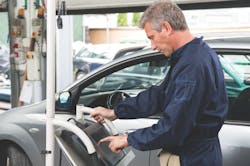In the retail world, point of sale (POS) is typically the time and place where a transaction is completed. It allows a business to prepare an invoice for the consumer, but for the retailer it also can be used to track inventory and other financials. The key requirement in a modern POS system is high and consistent operating speed, reliability, ease of use, remote support, low cost and intuitive interface and simple functionality.
POS systems have evolved greatly since Martin Goodwin and Bob Henry created the first true POS software for the Microsoft Windows platform in 1992. IT Retail was rather generic even at the time, but in the past 23 years many businesses have seen specialized POS systems take advantage of today’s low-cost computers.
Today, POS systems have evolved and cater to specific industries. For the quick lube world, the POS is very different than what a big box retailer or restaurant might use. It is still about providing a quick transaction for the consumer, but for today’s shops, POS systems include almost anything that might be necessary to know about a particular vehicle.
“What is handy for POS in this industry is the system can match the car with the store inventory and make recommendations as to the proper part and showcase the benefits to the user,” said Rob Enderle, principal technology analyst at the Enderle Group.
“For instance, the right viscosity and type of oil, filters and even showcase endemic problems the owner might want the store to look for,” Enderle added. “It provides a significant up-sell and customer satisfaction capability which can pay for the system in months and is particularly helpful when the staff isn’t deeply trained.”
The Quick Lube POS
Before the era of low-cost computers, most operators had to rely on printed manuals such as Chek Chart, which provided all the information one might need, but it required a bit of customer patience as the information was slow to retrieve. The digital age changed all that.
“Chek Chart was the bible for the industry as it contained all the data that anyone could ever want,” said Steve Barram, CEO of Integrated Services, Inc. (ISI). “But in a business where the customer expects to be in and out quickly, you need something faster. Software needs to be faster than manual input.”
ISI developed its software to provide operators all the information they would need from an electronic service manual (ESM) and provide motor data including year, model, make and engine. Today, that information can be obtained by quickly entering the VIN number — giving quick lube operators all the information they need to know to have the customer on their way.
“POS is a tool. It is about the operations procedures that dictate how the business runs,” Barram added. “It is a core, albeit critical, tool that is designed to fit within operational procedures.”
As noted, unlike other businesses this POS is very tailored to quick lube, and it is really there to help make it easier for shops to focus on what they do best.
“This is unique to this industry,” said Ash Bullard, vice president of sales and marketing at PM Attendant, Inc. The company’s roots go back to 2001, and since that time, it has developed a 100-percent online POS system.
“Everyone else in the business making this software is running it on PC or LINUX, but we’ve taken this to the cloud,” Bullard added.
Necessities of Ongoing Training
Most vendors of POS systems can help a shop get set up and running rather quickly, but ongoing training is important for quick lube operators to ensure they stay up-to-date with increasingly technical vehicles.
“It is absolutely true, cars today are getting more technical, but we’re trying to help our customers by providing all this information in the POS software,” Bullard said. “Even resetting the oil light can now be managed through POS.”
Understanding everything the POS does further requires shops continue training, because in the world of computers there are constant updates — some for security reasons while others are to address performance. POS software is upgraded for many of the same reasons.
“We stretch the training out over a period of time, but it all comes down to helping a shop be the best business they can be, and it is about getting the customer taken care of very quickly,” Bullard said. “That remains an important piece of the training.”
The lack of training on a POS system can mean a shop is missing out on an opportunity to become a better business; a more efficient business. For this reason, it is necessary when a POS system is put in place most employees should get some training. Of course, what the techs get trained on for use in the bays may be just a fraction of what the assistant manager or general manager may get.
“Training can be more specific for the role the employee plays in the operation,” Barram said. “Our software is still built around our reputation and around the support we offer to the shops.”
Taking to the Cloud
Buzz words such as “cloud computing” and “big data” may be part of the norm today in Silicon Valley, but understanding these terms can be very off putting for many quick lube operators. However, these are really rather simple concepts.
Big data is the tremendous amount of information being created each day — and with each passing year there is much more of this information to maintain. POS systems streamline this by putting it on a screen instead of a shelf.
The cloud, meanwhile, has allowed for the data to be taken off the local system and stored remotely. It is accessed via an Internet connection. This means it can be accessed on any computer with a connection, but for some, this has caused concern that proper training can help alleviate.
“We’ve seen potential customers who are afraid of the cloud,” Bullard said. “The fear is ‘I can’t touch or feel it, so do I control it?’ But I have to counter that if you can touch it you can steal it, then you don’t have anything.”
Integrated Services, Inc.’s LubeSoft and Modulube solutions are also cloud based, which can be accessed through any browser.
“All relevant data is there, and you can even do all sorts of reporting from multiple stores,” Barram said. “For those who worry an Internet outage will ruin the day, we still offer a local version for the shops. This is a very inexpensive way to ensure the system is running 99.99 percent of the time.”
Getting the Most of Your POS
Added training also can ensure the customer is getting the most out of the software. Ongoing training can ensure shops can better manage shrinkage, including stopping employee theft through better inventory control. It can also aid in ancillary sales, where the shop owner can check to see how his/her shop compares to national averages.
“We see vendors that are paying $120 to $300 a month for a POS system but a lot are still only using it for vehicle information – such as what filter goes in and to reset the oil light,” Bullard added. “These systems can do much, much more. It is about being a better business owner. I see there is a thought that if it isn’t broken don’t fix it, but then you’re not really using this as the business management tool that it should be. That’s only because those shop owners aren’t getting trained.”
About the Author

Peter Suciu
Peter Suciu is Michigan-based writer and NOLN freelance contributor who has contributed to more than four dozen magazines, newspapers and websites. He lives in the land of cars not far from one of Henry Ford's estates.
